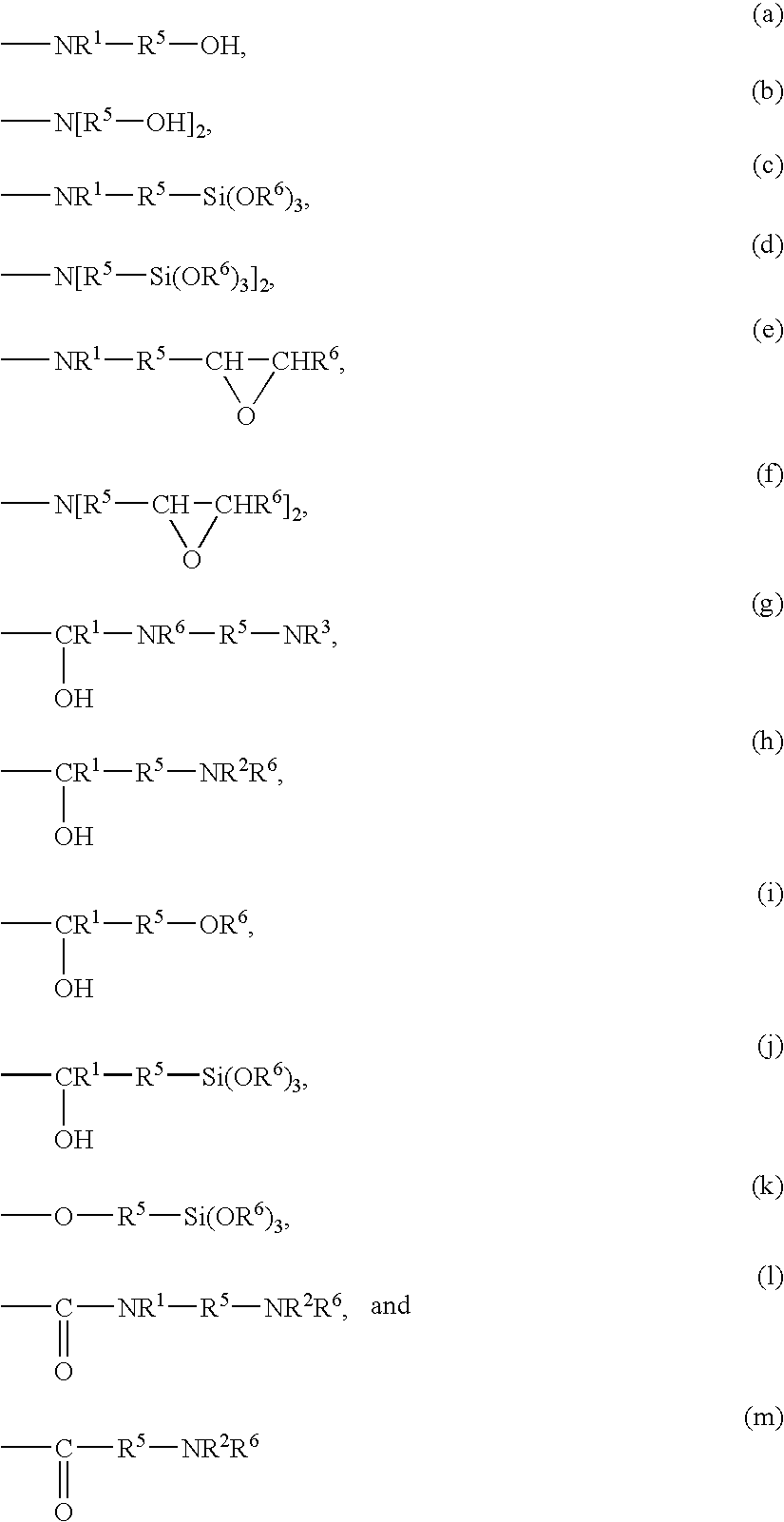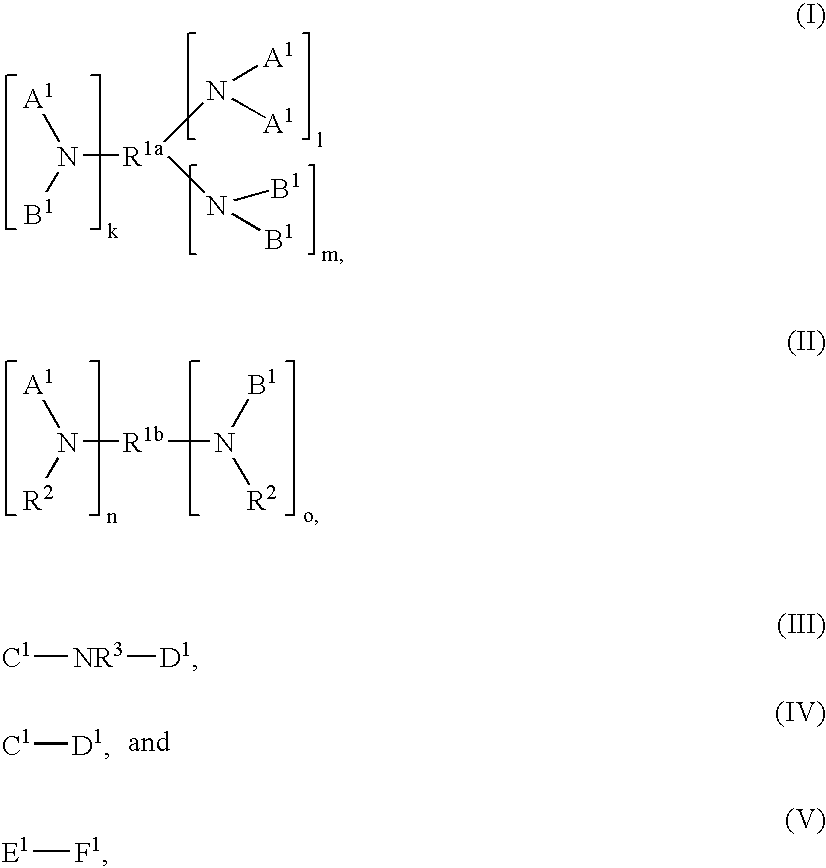Modified polymers and compositions containing the same
a technology of modified polymers and compositions, applied in the direction of graft polymer adhesives, adhesive types, building components, etc., can solve the problems of poor affinity of modified polymers to thermoplastic resins and/or rubbery polymers, inorganic fillers, polar group-containing additives, etc., and achieve excellent properties
- Summary
- Abstract
- Description
- Claims
- Application Information
AI Technical Summary
Benefits of technology
Problems solved by technology
Method used
Image
Examples
examples 1 to 18 and 70
, REFERENCE EXAMPLES 1 TO 14 AND COMPARATIVE EXAMPLES 1 TO 4
[0520] A first-order modified, unhydrogenated polymer was obtained using the living polymers indicated in Table 1 and the first-order modifiers indicated in Table 2. Specifically, to the living polymer solutions were individually added predetermined amounts of first-order modifiers as indicated in Table 2, and a reaction was performed at 70° C. for 20 minutes, thereby obtaining reaction mixtures respectively containing first-order modified, unhydrogenated polymers.
[0521] A first-order modified, hydrogenated polymer was obtained by hydrogenating the above-obtained first-order modified, unhydrogenated polymer using the above-mentioned hydrogenation catalyst I or hydrogenation catalyst II. Specifically, to a reaction mixture containing a first-order modified, unhydrogenated polymer was added hydrogenation catalyst I or hydrogenation catalyst II in an amount of 100 ppm in terms of the amount of titanium, relative to 100 parts ...
examples 19 to 21 , 23 to 34 , 36 to 43 and 71
EXAMPLES 19 TO 21, 23 TO 34, 36 TO 43 AND 71
[0524] Preparation of a Second-Order Modified Polymer
[0525] The first-order modified, hydrogenated polymer and a first-order modified, unhydrogenated polymer obtained in Examples 1 to 18 and 70 and Reference Examples 1 to 13 were individually reacted with a second-order modifier in accordance with the formulations indicated in Table 3, thereby obtaining second-order modified polymers. To the first-order modified, hydrogenated polymers (prepared in the Examples) and the first-order modified, unhydrogenated polymers (prepared in the Reference Examples) were individually added predetermined amounts of second-order modifiers (a functional monomer or a functional oligomer) as indicated in Table 3. The resultant mixtures were individually kneaded by means of an enclosed kneader (internal volume: 1.7 liters) which has two rotors and is equipped with a temperature control device employing a circulating water. The kneading was performed under cond...
example 22
[0526] To the reaction mixture containing the first-order modified, unhydrogenated polymer 1P-9 (obtained in Example 9), which was obtained by adding a first-order modifier to a solution of a living polymer, was added methanol in a molar amount which is 10 times the molar amount of n-butylithium used in the polymerization reaction. Then, carbonated water was added to the resultant, so as to adjust the pH value of the resultant to pH 8 or less. To the resultant mixture was added a predetermined amount of a second-order modifier (a functional monomer) as indicated in Table 3, and a reaction was performed at about 60° C. for 30 minutes. To the resultant reaction mixture was added, as a stabilizer, octadecyl-3-(3,5-di-t-butyl-4-hydroxyphenyl)propionate in an amount of 0.3 part by weight, relative to 100 parts by weight of the polymer, followed by steam stripping to thereby distill off the solvent in the reaction mixture. The resultant polymer was dehydrated and dried, to thereby obtain ...
PUM
| Property | Measurement | Unit |
|---|---|---|
| molecular weight distribution | aaaaa | aaaaa |
| molecular weight distribution | aaaaa | aaaaa |
| molecular weight distribution | aaaaa | aaaaa |
Abstract
Description
Claims
Application Information
 Login to View More
Login to View More - R&D
- Intellectual Property
- Life Sciences
- Materials
- Tech Scout
- Unparalleled Data Quality
- Higher Quality Content
- 60% Fewer Hallucinations
Browse by: Latest US Patents, China's latest patents, Technical Efficacy Thesaurus, Application Domain, Technology Topic, Popular Technical Reports.
© 2025 PatSnap. All rights reserved.Legal|Privacy policy|Modern Slavery Act Transparency Statement|Sitemap|About US| Contact US: help@patsnap.com



